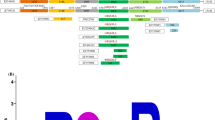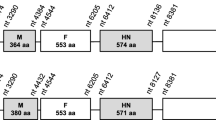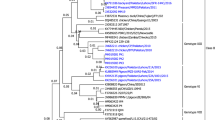Abstract
Nucleotide sequence analysis was completed for isolates of Newcastle disease virus (NDV; avian paramyxovirus 1) from 1992 outbreaks in cormorants and turkeys. These isolates were of the neurotropic velogenic type. The cormorant and turkey NDV isolates had the fusion protein cleavage sequence109SRGRRQKR/FVG119, as opposed to the consensus sequence109SGGRRQKR/FIG119 of most known velogenic NDV isolates. The R for G substitution at position 110 may be unique for the cormorant and turkey isolates. For comparative purposes, nucleotide sequencing and analysis of the conserved matrix protein gene coding region were completed for isolates representing all pathotypes. Phylogenetic relationships demonstrated that there are two major groups of NDV isolates. One group includes viruses found in North America and worldwide, such as B1, LaSota, Texas/GB, and Beaudette/C. The second group contains isolates, such as Ulster/2C, Australia/Victoria, and Herts/33, considered exotic to North America. Within this second group are viruses of psittacine origin. The viruses from 1992 outbreaks of Newcastle disease in North America, and an isolate thought to have caused the major outbreak in southern California during the 1970s, are most closely related to an NDV isolate of psittacine origin.
Similar content being viewed by others
References
Alexander D.J. in Calnek B.W., Barnes H.J., Beard C.W., Reid W.M., and Yoder H.W. Jr. (eds).Diseases of Poultry, 9th ed. Iowa State University Press, Ames, IA, 1991, pp. 496–519.
Kaletta E.F. and Baldauf C. in Alexander D.J. (ed).Newcastle Disease. Kluwer Academic Publishing, Boston, 1988, pp. 197–265.
Doyle T.M., J Comp Pathol Ther40. 244–169, 1927.
Kraneveld F.C., Ned Indisch Bl Diergeneesk38 448–450, 1926.
Alexander D.J. in Purchase H.G., Arp L.H., Domermuth C.H., and Pearson J.E. (eds).A Laboratory Manual for the Isolation and Identification of Avian Pathogens, 3rd ed. American Association of Avian Pathologists, Kennett Square, PA, 1989, pp. 114–120.
Senne D.A., Pearson J.E., Miller L.D., and Gustafson G.A., Avian Dis27 731–744, 1983.
Bruning-Fann C., Kaneene J., and Heamon J., J Am Vet Med Assoc201 1709–1714, 1992.
Panigrahy B., Senne D.A., Pearson J.E., Mixson M.A., and Cassidy D.R., Avian Dis37 254–258, 1993.
Utterback W.W. and Schwartz J.H., J Am Vet Med Assoc163 1080–1088, 1973.
Schloer G., Infect Immun10 724–732, 1974.
Wobeser G., Leighton F.A., Norman R., Myers D.J., Onderka D., Pybus M.J., Neufeld J.L., Fox G.A., and Alexander D.J., Can Vet J34 353–359, 1993.
Bannerjee M., Reed W.M., Fitzgerald S.D., and Panigraphy B., Avian Dis38 873–878, 1994.
Nagai Y., Klenk H.D., and Rott R., Virology72 494–508, 1976.
Glickman R.L., Syddall R.J., Iorio R.M., Sheehan J.P., and Bratt M.A., J Virol62 354–356, 1988.
Lê Long L., Brasseur R., Wemers C., Meulemans G., and Burny A., Virus Genes1 333–350, 1988.
Gotoh B., Ohnishi Y., Inocencio N.M., Esaki E., Nakayama K., Barr P.J., Thomas G., and Nagai Y., J Virol66 6391–6397, 1992.
Ogasawara T., Gotoh B., Suzuki H., Asaka J., Shimokata K., Rott R., and Nagai Y., EMBO J11 467–472, 1992.
Millar N.S., Chambers P., and Emmerson P.T., J Gen Virol69 613–620, 1988.
Sakaguchi T., Toyoda T., Gotoh B., Inocencio N.M., Kuma K., Miyata T., and Nagai Y., Virology169 260–272, 1989.
Toyoda T., Sakaguchi T., Hirota H., Gotoh B., Kuma K., Miyata T., and Nagai Y., Virology169 273–282, 1989.
Morse S.S.,The Evolutionary Biology of Viruses. Raven Press, New York, 1994.
Afzal M.A., Pickford A.R., Yates P.J., Forsey T., and Minor P.D., J Gen Virol75 1169–1172, 1994.
Rota P.A., Bloom A.E., Vanchiere J.A., and Bellini W.J., Virology198 724–730, 1994.
Cheville N.F., Stone H., Riley J., and Ritchie A.E., J Am Vet Med Assoc161 169–179, 1972.
Schloer G.M. and Hanson R.P., J Virol2 40–47, 1968.
Hitchner S.B., Avian Dis19 215–223, 1975.
Goldhaft T.M., Avian Dis24 297–301, 1980.
McFerran J.B., Gordon W.A.M., and Finlay T., Vet Rec82 589–592, 1968.
French E.L., St. George T.D., and Percy J.J., Aust Vet J43 404–409, 1967.
Sato H., Oh-hira M., Ishida N., Imamura Y., Hattori S., and Kawakita M., Virus Res7 241–255, 1987.
Schaper U.F., Fuller F., Ward M.D., Mehrotra Y., Stone H.O., Stripp B.R., and De-Buysscher, Virology165 291–295, 1988.
Beaudette F.R., Bivins J.A., and Miller B.R., Cornell Vet39 203–334, 1949.
Chambers P., Millar N.S., and Emmerson P.T., J Gen Virol67 2685–2694, 1986.
Chambers P., Millar N.S., Platt S.G., and Emmerson P.T., Nucleic Acids Res14 9051–9061, 1986.
Albiston H.E. and Gorrie C.J.R., Aust Vet J18 75–79, 1942.
McGinnes L.W. and Morrison T., Virus Res5 343–356, 1986.
McGinnes L.W. and Morrison T., Virology156 221–228, 1987.
Alexander D.J. and Allan W.J., Avian Pathol4 269–278, 1974.
Lana D.P., Snyder D.B., King D.J., and Marquardt W.W., Avian Dis32 273–281, 1988.
Chomzcynski P. and Sacchi N., Anal Biochem162 156–159, 1987.
Lewis J.G., Chang G-J., Lanciotti R.S., and Trent D.W., J Virol Methods38 11–24, 1992.
Kotewicz M.L., Sampson C.M., D'Alessio D.E., and Gerard G.F., Nucleic Acids Res16 265–277, 1988.
Sanger F., Nickles S., and Carlson A.R., Proc Natl Acad Sci USA74 5463–5467, 1977.
Smith L.M., Sanders J.Z., Kaiser R.J., Hughs P., Dodd C., Connell C.R., Heines C., Kent S.B.H., and Hood L.E., Nature321 673–681, 1986.
Mead D.A., Pey N.K., Herrnstadt C., Marcil R.A., and Smith L.A., Biotechnology9 657–662, 1991.
Sneath P.H.A. and Sokal R.R.,Numerical Taxonomy. Freeman, San Francisco, 1973.
Swafford D.,PAUP: Phylogenetic Analysis Using Parsimony, Version 3. Illinois Natural History Survey, Champaign, IL, 1989.
Kumar S., Tamura K., and Nei M.,MEGA: Molecular Evolutionary Genetics Analysis, Version 1.01. The Pennsylvania State University, University Park, PA, 1993.
Alexander D.J., Campbell G., Manvell R.J., Collins M.S., Parsons G., and McNulty M.S., Vet Rec130 65–68, 1992.
Collins M.S., Bashiruddin J.B., and Alexander D.J., Arch Virol128 363–370, 1993.
Ina I. and Gojobori T., Proc Natl Acad Sci USA91 8388–8392, 1994.
Faaberg K.S. and Peeples M.E., J Virol62 586–593, 1988.
Coleman N.A. and Peeples M.A., Virology195 596–607, 1993.
Author information
Authors and Affiliations
Corresponding author
Rights and permissions
About this article
Cite this article
Seal, B.S. Analysis of matrix protein gene nucleotide sequence diversity among Newcastle disease virus isolates demonstrates that recent disease outbreaks are caused by viruses of psittacine origin. Virus Genes 11, 217–224 (1995). https://doi.org/10.1007/BF01728661
Issue Date:
DOI: https://doi.org/10.1007/BF01728661




